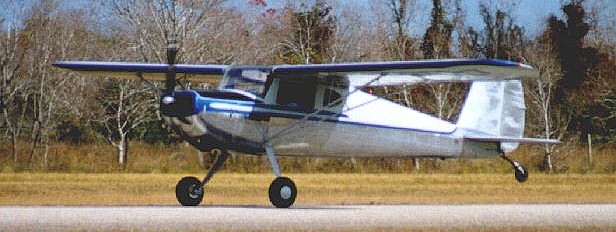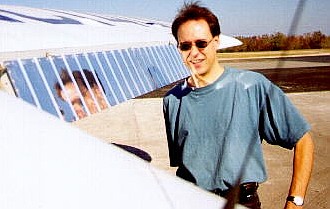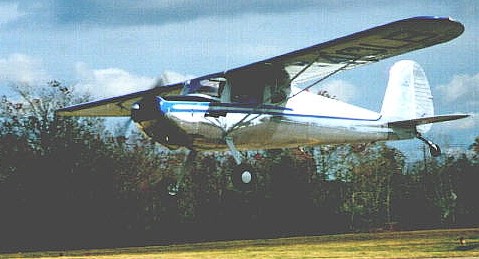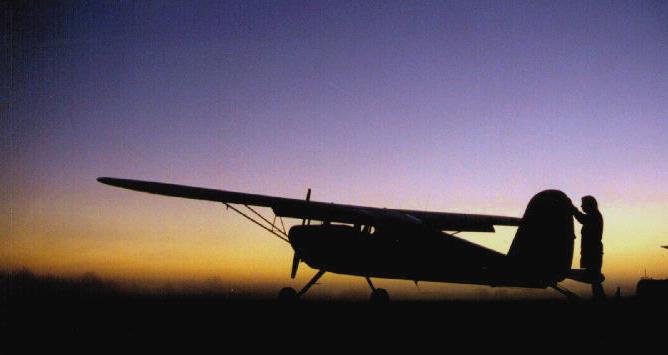
| THE 1946 CESSNA 140 |
|---|

The Cessna 140 experience is new to me. It's my first dip into the deep pool of aircraft ownership. I've been after a 140 for a long time, and my friends, Paul and Jenny Reinman have been enthusiastic in this direction too...so what better than to go into partnership! We discovered a beatiful 1946 Cessna Model 140 for sale in hangar 22 at Houston Gulf, so we took the plunge. The photograph above was taken the day we were getting checked out (November 25th 1999). Paul was flying in the above photograph - this picture was taken with him on the takeoff roll.
Some people might think I'm crazy in buying a share in a plane older than my father. However, the Cessna 140 has some real magic. Read on...
| -- A different world -- |
|---|
The Cessna 140 is from a different era from even the fairly old aircraft most GA pilots fly. In those days, you didn't even need an attitude indicator to fly IFR. The well-known double tapered Cessna wing wasn't used in those days: the 140 has a constant chord "Hershey bar" wing with rounded wingtips. The tailfeathers are curved in an elliptical shape, rather than the straight or swept versions on later airplanes. Of course, it was the norm to have the little wheel at the back, too. It's quite interesting to read through the owner's manual (no POH's back then!) and to look at all the old photographs.
 Our particular aircraft is half polished, half painted. This
makes it look very nice, but polishing is quite a lot of work! When we got
the plane we had two jobs: get the annual done, and polish the metalwork.
The prebuy noted that everything was in good shape, and the AI who did the
pre-buy also did the annual, so the annual would not be much additional work.
The photo here shows Paul and Jenny polishing (I'm slouching off and taking
the photo!) To give you an idea of how much polishing we had to do, we
were there from about 2pm until 10pm at night! It was worth it in the end,
the finish was extremely bright once we were done. The initial polish was
done with "Flitz" and a great deal of elbow grease. To finish off, we waxed
(to protect the metal) and buffed with an electric buffer. The belly was
definitely the worst bit. In addition, we pulled the cowling and inspection
covers so our IA could get on with the annual unhindered. We also had the
plane treated with "Boe-shield", which is a corrosion inhibitor. This is
quite important in the moist air of south east Texas!
Our particular aircraft is half polished, half painted. This
makes it look very nice, but polishing is quite a lot of work! When we got
the plane we had two jobs: get the annual done, and polish the metalwork.
The prebuy noted that everything was in good shape, and the AI who did the
pre-buy also did the annual, so the annual would not be much additional work.
The photo here shows Paul and Jenny polishing (I'm slouching off and taking
the photo!) To give you an idea of how much polishing we had to do, we
were there from about 2pm until 10pm at night! It was worth it in the end,
the finish was extremely bright once we were done. The initial polish was
done with "Flitz" and a great deal of elbow grease. To finish off, we waxed
(to protect the metal) and buffed with an electric buffer. The belly was
definitely the worst bit. In addition, we pulled the cowling and inspection
covers so our IA could get on with the annual unhindered. We also had the
plane treated with "Boe-shield", which is a corrosion inhibitor. This is
quite important in the moist air of south east Texas!
 Once done with the polishing and annual, we had an insanely
shiny plane we needed to fly! As you can see, we could literally use the
flaps as a mirror. The drawback of this shinyness is that we're going to
have to wax all the metal about once a month to prevent it tarnishing -
but I think it's worth it. We keep getting complimented on having such a
nice looking plane.
Once done with the polishing and annual, we had an insanely
shiny plane we needed to fly! As you can see, we could literally use the
flaps as a mirror. The drawback of this shinyness is that we're going to
have to wax all the metal about once a month to prevent it tarnishing -
but I think it's worth it. We keep getting complimented on having such a
nice looking plane.
Flying is where the real fun starts of course! Preflight is the same as with the Cessna 170, except the plane isn't quite as large. Taxiing is a little bit different to in the 170, since you can't see as much over the nose. However, the view isn't too bad - with a little stretching, you can taxi without the need for S-turns. The tailwheel is steerable by means of a spring linkage from the rudder cables, making control during taxi pretty easy.
Our 140 has the 85 horsepower Continental C85. The run-up is conventional, and doesn't take long (which is an advantage of a simple aircraft). However, when you pull onto the runway and throttle up, the engine only turns at 2200 rpm! This seems quite leisurely compared to anything I've flown before. The tail quickly lifts, and you get a really good forward view. Climb out is done at 73 mph. As you can imagine, the rate of climb isn't astounding (and we haven't even got a VSI in the plane to measure it by, anyway!) However, due to the relatively slow climbout speed, the angle of climb isn't all that bad.
The first thing we did for my checkout was to go out to the practise area to do the "high" airwork - stalls, steep turns and slow flight. The aircraft is actually extremely responsive. The control surfaces are pretty large - even the ailerons are big compared to the Cessna 150. The roll rate is fairly quick, and all the controls, including the rudder require only a gentle touch to get the desired response. The plane is in very good rig - flying straight with hands and feet off the controls. This makes the plane a lot of fun to fly. It's almost like you can just think of what you want to do, and the aircraft responds. This is of course something that's very good in a taildragger, where being able to make quick corrections is very helpful when there's a gusty crosswind on final.
With only 85 horsepower at our disposal, steep turns required a good dollop of extra power over cruise, but were pretty easy to accomplish. Our aircraft has neither a VSI nor an attitude indicator, so you just have to estimate how much bank angle you have (it's pretty easy to tell that you're close to 60 degrees and level by the G-forces you can feel). It's not hard to maintain altitude as you enter, perform then exit the steep turn. Onto slow flight, the controls remain effective as the airspeed indicator winds down. The aircraft isn't equipped with a stall horn, so I just slowed down until the needle was a little below Vs0. The controls do get mushier as you'd expect once you go this slow, but it's pretty much like flying a Cessna 150 in slow flight - no particular surprises.
Even though the 140 has a different wing planform to a Cessna 150 or 152, the stall characteristics were remarkably similar. The stall break is sharp and clean, and can easily be controlled by using the rudder. If the stall is entered uncoordinated, the aircraft has a tendency to drop a wing quite sharply. The plane doesn't have a stall warner, so you have to rely on aerodynamic warnings (which are quite good - there's noticable buffet before the stall, and the controls get mushy). The 140 is approved for spins (with flaps up) too. The power on stall is quite sharp, and is once again you can easily stop a wing from dropping with proper use of the rudder. I also tried an experiment in stalls. You often hear how cross controlled stalls result in spins. However, this is too much of a generalization. A stall whilst in a skid will give you a good spin entry - however, a stall when entered in a slip will behave quite differently. I've heard that quite a few people shy away from slipping it in on final (or add some extra airspeed when they do so out of fear from a low altitude spin, kind of negating the point of slipping!) I had heard that in actual fact, a slip is a spin resistant manouever. I therefore decided to try it, with the benefit of having John Sollinger, an instructor with aerobatic experience (and who owns the CJ6) on board.
We tried a slip both to the left and to the right. I slowed the plane down, and entered the slip with full rudder deflection and sufficient aileron to keep the aircraft tracking a straight line over the ground. The power was at idle, and I pulled the yoke back until it was all the way to the stop. What happened next was quite interesting. Instead of doing anything drastic, the plane started to simply mush, with the nose bobbing up and down. There was a significant amount of buffet. However, the nose didn't really drop much, and the bank angle didn't change by any significant amount. In the Cessna 140, it certainly seems true that slips are spin resistant! Of course, the descent rate was pretty good in this regime.
 The 140 is actually quite docile to land. Of course, in the
world of tailwheel aircraft, I only have experience in the 170 in addition
to this! The 140 seems a bit easier to three-point than the 170, but a little
harder to wheel land. A normal approach is made at 70 mph indicated.
At this point, you can notice a difference between the 140 and the later
taper-wing Cessnas - the 140 tends to have a higher sink rate at approach
speeds compared to the later Cessnas which really do benefit from barn door
flaps. Flare technique, however, worked just the same as in the 170.
A gentle pull on the "Pretzel yoke" brought the plane into a 3-point attitude,
and after a little float, the plane touched down for a 3-point landing.
The 140 does seem to be a bit more docile on landing than the 170 - it seems
a lot less inclined to bounce if you slightly misjudge your flare height.
As the wheels touch down, the yoke is pulled all the way aft to nail the
tailwheel down. You can make impressively short field landings due to the
low touchdown speed. Within a couple of days of the plane in flying status,
Paul had landed at Alvin Airpark (a 1500 foot grass strip) very easily.
The 140 looks good at a grass airstrip: on the Saturday after we started
flying, I went up to the Soaring Club of Houston, whose runway is basically
a 3000-foot cow pasture. Michael Masterov had invited me to be "ballast"
in a glider (he's working on his commercial glider rating). I parked next
to his 1955 Tri-Pacer and a Maule.
Later on, a Stearman came in. The club uses Pawnees as glider tugs, and
the 140 looked right at home amongst these planes! (And now I'm going to
have to take up soaring too, that was a lot of fun...but that's a story
for another day!)
The 140 is actually quite docile to land. Of course, in the
world of tailwheel aircraft, I only have experience in the 170 in addition
to this! The 140 seems a bit easier to three-point than the 170, but a little
harder to wheel land. A normal approach is made at 70 mph indicated.
At this point, you can notice a difference between the 140 and the later
taper-wing Cessnas - the 140 tends to have a higher sink rate at approach
speeds compared to the later Cessnas which really do benefit from barn door
flaps. Flare technique, however, worked just the same as in the 170.
A gentle pull on the "Pretzel yoke" brought the plane into a 3-point attitude,
and after a little float, the plane touched down for a 3-point landing.
The 140 does seem to be a bit more docile on landing than the 170 - it seems
a lot less inclined to bounce if you slightly misjudge your flare height.
As the wheels touch down, the yoke is pulled all the way aft to nail the
tailwheel down. You can make impressively short field landings due to the
low touchdown speed. Within a couple of days of the plane in flying status,
Paul had landed at Alvin Airpark (a 1500 foot grass strip) very easily.
The 140 looks good at a grass airstrip: on the Saturday after we started
flying, I went up to the Soaring Club of Houston, whose runway is basically
a 3000-foot cow pasture. Michael Masterov had invited me to be "ballast"
in a glider (he's working on his commercial glider rating). I parked next
to his 1955 Tri-Pacer and a Maule.
Later on, a Stearman came in. The club uses Pawnees as glider tugs, and
the 140 looked right at home amongst these planes! (And now I'm going to
have to take up soaring too, that was a lot of fun...but that's a story
for another day!)
To conclude, the 140 is a great plane to fly, even if you're not going to go very fast! The fuel burn is low, and there's not much to go wrong, so ownership shouldn't work out too expensive. I'm sure I'll have many happy hours of flying!

Photographs by Paul Reinman, Jenny Reinman and Dylan Smith.